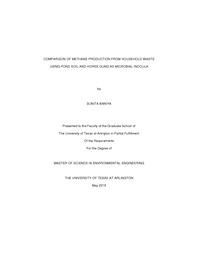| dc.description.abstract | Anaerobic digestion is a biochemical process in which various microorganisms transform complex organic compounds to methane, along with carbon dioxide, water vapor and a small amount of other trace gases in absence of oxygen. Methane from anaerobic digestion processes is being increasingly utilized as an alternative energy source in developing as well as developed countries. These days the energy crisis is very acute in rural communities of developing countries, where fuelwood has been and still is the major source of daily used fuel. Through anaerobic digestion, clean-burning fuel for cooking can be produced from degradation of household organic wastes, solving two global environmental problems at once, waste management and renewable energy.
However for the successful operation of a digester, selection of inoculating microbes is crucial. If an active inoculum is selected, failure of overall the process can be avoided during the initial/start-up phase. Previous studies have found sewage sludge to be an effective inocula. However, as mentioned, one of the most important applications of small-scale anaerobic digesters is in the rural areas of low income countries. Using sewage sludge as a seed for an anaerobic digester is not an option in these cases since most developing countries do not have wastewater treatment facilities in the rural areas. Pond bottom soil and dungs from various animals can be easily available in the rural areas of low income countries.
Methanogens are common in nature at the bottom of stagnated ponds, lakes, and swamps or wetlands, where they produce methane, which is also known as swamp gas or marsh gas, in anoxic conditions, as well as in digestive tracts of animals. Several studies have been done to examine the animals dung as an inocula but pond bottom soil has not been examined in previous digester studies.
The main objectives of the current study were to compare the rate of methane production and cumulative methane generation from degradation of a mixture of household organic wastes (food, paper, and yard) using 2 types of pond soil and horse dung as an inocula, and to determine the effectiveness of the best inoculum from the first experiment in degrading mixtures with various proportions of food, paper and yard waste. To accomplish this, three kinds of inocula - Pond bottom soil 1, Pond bottom soil 2 and Horse dung - were obtained from two different ponds and outdoor loafing sheds near Keller, Texas. Waste samples, including Food, Paper and Yard waste, were collected from a house. Three laboratory scale reactors were prepared with selected household waste and inoculum and operated at room temperature. Duplicate runs were conducted. The pH level of reactors was controlled by adding sodium hydroxide.
For the duplicate sets of reactors in experiments, reactors inoculated with Pond1 started gas formation sooner, and peaked earlier than the Pond 2 and Horse dung reactors. For both sets of reactors, the reactor seeded with pond bottom soil obtained from Pond1 had the highest methane generation rate, as well as the largest cumulative volume of methane, followed by Pond 2 and finally the reactor seeded with Horse dung. The possible reason is that Pond 1 is an older pond compared to Pond 2, and the bottom soil obtained from the Pond1 may have more stable organic matter accumulated as well as higher nutrient concentrations, leading to higher numbers and variety of microbes. The cumulative average methane generation in 95 days, for the reactor seeded with Pond 1 was 19.4 % higher than reactor seeded with Pond 2 and 72% higher than reactor seeded with Horse dung. Similarly, reactor Pond 2 generated 44% more methane than the reactor with the Horse dung. Pond soils obtained from the Pond 1 and Pond 2 gave better performance than horse dung as an inoculum for treating household wastes.
Another experiment was the further testing of the effectiveness of best inoculum from the first experiments in degrading mixtures with various proportions of food, paper and yard waste. All reactors were inoculated with digested waste of Pond1 (B).The reactor with more Food started gas formation sooner than Paper and Yard. It is likely because of food waste decomposes faster. For all three reactors (Food, Paper and Yard) through the 68 days of reactor operation, Food waste had the highest rate of methane generation as well as largest cumulative volume of methane, likely because food waste has the highest amount of cellulose, and more surface areas per unit volume of waste for the microbes to access, than paper and yard waste. | |


